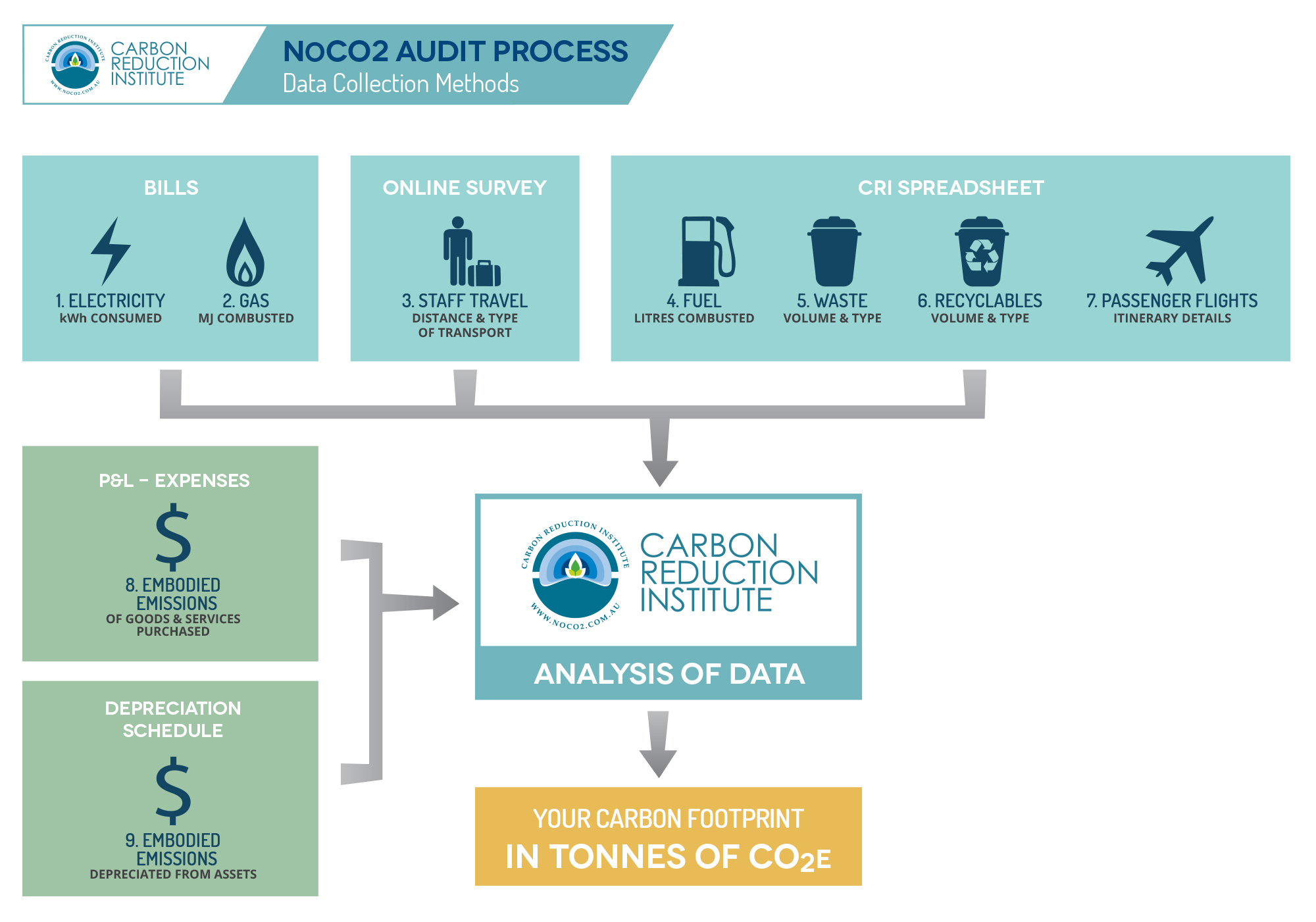
Carbon Footprint
A carbon footprint is the total amount of carbon dioxide (CO2) and other greenhouse gases (GHG) emitted over the full life cycle of a product or service, or in any given financial year.
The measurement is usually expressed as kilograms of CO2 equivalents, which accounts for the global warming effects from different greenhouse gases.
Carbon Footprint Audit
The first step in managing the impact of an organisation’s greenhouse gas emissions, commonly known as the carbon footprint, is to conduct a measurement, referred to as a carbon audit.
The Carbon Reduction Institute (CRI) does this by conducting a comprehensive emissions audit using methodology adapted from the World Business Council for Sustainable Development Greenhouse Gas Protocol.

Types of Audits
Depending on the level of certification required, there are five types of audits undertake by CRI’s expert team.
1. NoCO2 Certification
The top tier assessment for businesses aiming to go carbon neutral. It covers all emissions the business is responsible for.
2. LowCO2 Certification
An ‘operational footprint’ study designed for businesses which cannot feasibly achieve NoCO2 or Carbon Neutral status.
3. Product life-cycle analysis
An inventory of all emissions in relation to the production and delivery of products.
4. Event assessment
Measures all of the inputs and outputs associated with running an event.
5. Customised
A great choice for businesses with specialised needs. For example, a NoCO2 audit for a winery will need to include information about grapes grown, fertilisers, types of packaging, etc.
Methodology Overview
The greenhouse gas (GHG) protocol used in all the audit levels conducted by CRI can be applied to different levels, sizes and types of organisations when compiling their GHG inventory.
This includes multi-nationals, energy intensive primary industry and small to medium enterprises (SME).
The procedure defines boundaries and emissions scopes to ensure that there is no double-counting on a national, state or industry level.
Emission scopes are vital when compiling a GHG inventory, as they give organisations consistency and clarity when charting their emissions liabilities.
Emissions Boundaries
There are two types of boundary that must be set when compiling a GHG inventory; an organisational boundary and an operational boundary.
Organisational boundaries allow a business to distinguish between GHG emitting activities that are attributable to their organisation and those that are not.
When setting these, CRI uses a control rationale, which states that organisations and/or businesses account for emissions generated from activities over which they have direct control, rather than an equity share.
CRI uses this methodology as it believes the consumer is responsible for the products and services they buy, and that the purchase is an endorsement of the methods used to produce the goods and services consumed.
Operational boundaries allow an entity to define the emissions that they own or control and categorise them into different pillars, or scopes, as either direct or indirect.
Dividing emissions up this way allows a business to better determine opportunities for emission reductions, as well as helping to pinpoint where their greenhouse gases are occurring along the ‘value chain’.
Scope 1: Direct GHG emissions
These are gases that occur from sources that are owned or controlled by the business, for example, emissions from combustion in company-owned (or controlled) boilers, furnaces and vehicles.
Scope 2: Electricity indirect GHG emissions
Emissions from the generation of purchased electricity consumed by the company.
Scope 3: Other indirect GHG emissions
Emissions that are a result of the activities of the company but occur from sources which are not owned or controlled by the company. These include emissions from waste, the extraction and production of purchased materials, and transportation of purchased fuels and employees to and from work.
What Happens Next?
As a result of the carbon footprint analysis, one of the most effective and important steps an organisation can take to lower its carbon footprint, a detailed audit report is generated for each client.
It is designed to provide an understanding of greenhouse inventory, and how this knowledge can be used to plan future reductions of a company’s carbon footprint.
By isolating each emission source, the report allows the organisation to determine and model emission reduction strategies, their payback and viability.
It also provides awareness of any reporting obligations under energy and emissions reporting legislation.
CERTIFY YOUR BUSINESS AS CARBON NEUTRAL
Reduce your carbon footprint
A few ways you can lower your Greenhouse Gas Emissions and in turn, reduce the carbon footprint of your business.
Switch to Green Power
In most office-based businesses, carbon emissions from electricity are the greatest carbon footprint component. Green power is renewable energy, sourced from the sun, wind, water and waste and it will lower your carbon footprint considerably.
Energy Efficiency for your Business
Starting with lighting, replace inefficient lighting with new energy efficient lights. Install time sensors that switch off lights when no one is in the room. This will not only reduce your Carbon Footprint but also save you money!
Staff Practices and Education
Encourage staff to take public transport or to car-pool and remind everyone to switch off computers, monitors and printers at night. Please visit our resources page for flyers and brochures that will help you to motivate your staff to take action against global warming.
Reduce Business Air Travel
Emissions from air travel are significant and if you fly staff domestically or internationally, this will have a big impact on your carbon footprint. A return economy flight to London from Sydney is responsible for 7.16 tonnes of GHG emissions. To calculate and offset the emissions from flying, please visit our Carbon Offset Calculator. An alternative to flying staff to meetings could be video conferencing. Please visit Broadreach Services or CO2NeutralConferencing.com for more information.
Fuel Switching
Many diesel engines can be run on biodiesel or a mix of diesel and biodiesel. For companies with fleets of trucks or diesel driven machinery, this is an effective method for lowering your carbon footprint. For more information on biodiesel visit the Biodiesel Association of Australia website.
